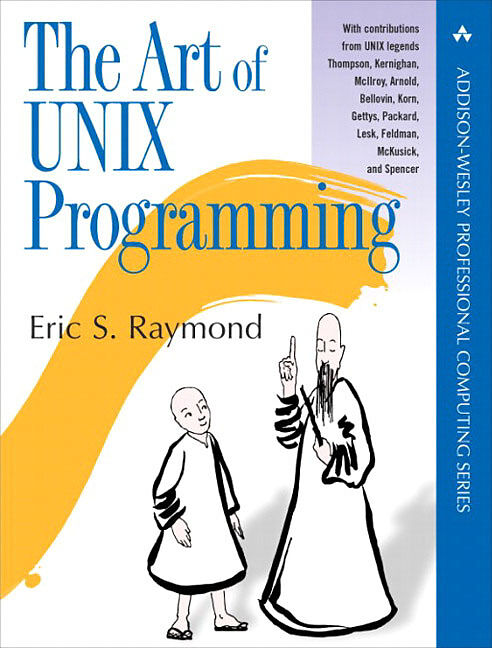Art of UNIX Programming, The
Einband:
Kartonierter Einband
EAN:
9780131429017
Untertitel:
Englisch
Genre:
Programmiersprachen
Autor:
Eric Raymond
Herausgeber:
Pearson Academic
Anzahl Seiten:
560
Erscheinungsdatum:
02.10.2003
ISBN:
978-0-13-142901-7
I. CONTEXT. 1. Philosophy.
Culture? What culture?The durability of Unix.The case against learning Unix culture.What Unix gets wrong.What Unix gets right.Basics of the Unix philosophy.The Unix philosophy in one lesson.
Applying the Unix philosophy.Attitude matters too.2. History.
Origins and history of Unix, 1969-1995.Origins and history of the hackers, 1961-1995.The open-source movement: 1998 and onward.The lessons of Unix history.3. Contrasts.
The elements of operating-system style.Operating-system comparisons.What goes around, comes around.II. DESIGN. 4. Modularity.
Encapsulation and optimal module size.Compactness and orthogonality.Libraries.Unix and object-oriented languages.Coding for modularity.5. Textuality.
The Importance of Being Textual.Data file metaformats.Application protocol design.Application protocol metaformats.6. Transparency.
Some case studies.Designing for transparency and discoverability.Designing for maintainability.7. Multiprogramming.
Separating complexity control from performance tuning.Taxonomy of Unix IPC methods.Problems and methods to avoid.Process partitioning at the design level.8. Minilanguages.
Taxonomy of languages.Applying minilanguages.Designing minilanguages.9. Transformation.
Data-driven programming.Ad-hoc code generation.10. Configuration.
What should be configurable?Where configurations live.Run-control files.Environment variables.Command-line options.How to choose among configuration-setting methods.On breaking these rules.11. Interfaces.
Applying the Rule of Least Surprise.History of interface design on Unix.Evaluating interface designs.Tradeoffs between CLI and visual interfaces.Transparency, expressiveness, and configurability.Unix interface design patterns.Applying Unix interface-design patterns.The Web browser as universal front end.Silence is golden.12. Optimization.
Don't just do something, stand there!Measure before optimizing.Non-locality considered harmful.Throughput vs. latency.13. Complexity.
Speaking of complexity.A Tale of Five Editors.The right size for an editor.The right size of software.III. IMPLEMENTATION. 14. Languages.
Unix's Cornucopia of Languages.Why Not C?Interpreted Languages and Mixed Strategies.Language evaluations.Trends for the Future.Choosing an X toolkit.15. Tools.
A developer-friendly operating system.Choosing an editor.Special-purpose code generators.Make in non-C/C++ Development.Version-control systems.Run-time debugging.Profiling.Emacs as the universal front end.16. Re-Use.
The tale of J. Random Newbie.Transparency as the key to re-use.From re-use to open source.The best things in life are open.Where should I look?What are the issue...
Autorentext
ERIC S. RAYMOND has been a Unix developer since 1982. Known as the resident anthropologist and roving ambassador of the open-source community, he wrote the movement's manifesto in The Cathedral and the Bazaar and is the editor of The New Hacker's Dictionary.
Klappentext
The Art of UNIX Programming poses the belief that understanding the unwritten UNIX engineering tradition and mastering its design patterns will help programmers of all stripes to become better programmers. This book attempts to capture the engineering wisdom and design philosophy of the UNIX, Linux, and Open Source software development community as it has evolved over the past three decades, and as it is applied today by the most experienced programmers.Eric Raymond offers the next generation of "hackers" the unique opportunity to learn the connection between UNIX philosophy and practice through careful case studies of the very best UNIX/Linux programs. In addition, commentary is provided by Brian Kernighan, UNIX pioneer and best-selling author; Doug McIlroy, the inventor of the UNIX pipg; David Korn, the inventor of the korn shell; Jim Gettys and Keith Packard, inventors of X windows; Henry Spencer, an original UNIX hacker; and Ken Arnold, an original BSD developer and JINI creator; Mike Lesk, author of the legendary uucp, lex, and tbl programs; and Sturat Feldman, author of UNIX's famous make utility.The book is divided into 4 parts. Part I explores the philosophy behind the development of UNIX. Part II explores design principles and patterns that are at the core of the UNIX tradition. Part III covers the rich UNIX tradition of reuse and the amazing variety of programming tools available to the UNIX developer. Part IV explores the UNIX open standards process, and the advantage in portability that UNIX enjoys.
Zusammenfassung
The Art of UNIX Programming poses the belief that understanding the unwritten UNIX engineering tradition and mastering its design patterns will help programmers of all stripes to become better programmers. This book attempts to capture the engineering wisdom and design philosophy of the UNIX, Linux, and Open Source software development community as it has evolved over the past three decades, and as it is applied today by the most experienced programmers. Eric Raymond offers the next generation of "hackers" the unique opportunity to learn the connection between UNIX philosophy and practice through careful case studies of the very best UNIX/Linux programs.
Inhalt
I. CONTEXT. 1. Philosophy.
Culture? What culture?The durability of Unix.The case against learning Unix culture.What Unix gets wrong.What Unix gets right.Basics of the Unix philosophy. The Unix philosophy in one lesson.
Applying the Unix philosophy.Attitude matters too. 2. History.
Origins and history of Unix, 1969-1995.Origins and history of the hackers, 1961-1995.The open-source movement: 1998 and onward.The lessons of Unix history. 3. Contrasts.
The elements of operating-system style.Operating-system comparisons.What goes around, comes around. II. DESIGN. 4. Modularity.
Encapsulation and optimal module size.Compactness and orthogonality.Libraries.Unix and object-oriented languages.Coding for modularity. 5. Textuality.
The Importance of Being Textual.Data file metaformats.Application protocol design.Application protocol metaformats. 6. Transparency.
Some case …

Leider konnten wir für diesen Artikel keine Preise ermitteln ...
billigbuch.ch sucht jetzt für Sie die besten Angebote ...
Die aktuellen Verkaufspreise von 6 Onlineshops werden in Realtime abgefragt.
Sie können das gewünschte Produkt anschliessend direkt beim Anbieter Ihrer Wahl bestellen.
Loading...
Die aktuellen Verkaufspreise von 6 Onlineshops werden in Realtime abgefragt.
Sie können das gewünschte Produkt anschliessend direkt beim Anbieter Ihrer Wahl bestellen.
| # | Onlineshop | Preis CHF | Versand CHF | Total CHF | ||
|---|---|---|---|---|---|---|
| 1 | Seller | 0.00 | 0.00 | 0.00 |
